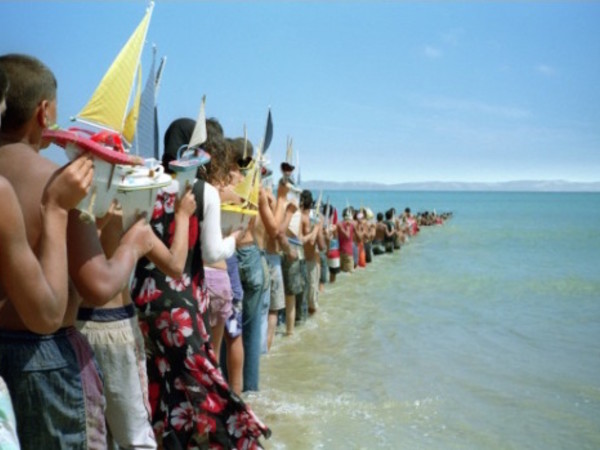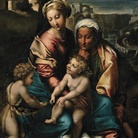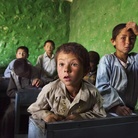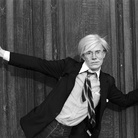The Restless Earth

© Francis Alÿs and David Zwirner, New York/London | Francis Alÿs in collaboration with Julien Devaux, Felix Blume, Ivan Boccara, Abbas Benheim, Fundecièon Montenmedio Arte, and children of Tanger and Tarifa / Don't cross the bridge before you get to the river, Strait of Gibraltar, 2008
From 28 Aprile 2017 to 20 Agosto 2017
Milan
Place: Triennale di Milano
Address: Viale Alemagna 6
Times: Tue - Sun 10.30 am - 8.30 pm
Responsibles: Massimiliano Gioni
Organizers:
- Fondazione Nicola Trussardi
- Fondazione Triennale di Milano
Ticket price: Full price 8 € | Reduced 6.50 € (for special categories) | Cumulative 10 €
E-Mail info: info@triennale.org
Official site: http://www.triennale.org/
La Triennale di Milano and the Fondazione Nicola Trussardi present La Terra Inquieta (The Restless Earth), an exhibition curated by Massimiliano Gioni and co-produced by the Fondazione Nicola Trussardi and Fondazione Triennale di Milano, as part of the Visual Arts Program of the Triennale directed by Edoardo Bonaspetti.
The exhibition, which will be open to the public from April 28 to August 20, 2017, is the result of a partnership between two institutions whose missions have always centered on the present, exploring the ways in which the experimental and innovative languages of contemporary art and culture can express radical changes in our world.
La Terra Inquieta borrows its title from a collection of poems by Édouard Glissant, a Caribbean writer who probed the question of how different cultures can coexist. The exhibition shares in Glissant’s project—a pressing and necessary one that tries to describe this unstable and agitated present as a polyphony of voices and narratives. Through the works of more than sixty artists from thirty-nine countries—such as Albania, Algeria, Bangladesh, Egypt, Ghana, Iraq, Lebanon, Morocco, Syria, and Turkey—which fill the ground-floor gallery of the Triennale and continue to the floor above, this exhibition charts both experiences and perceptions of migration and the current refugee crisis as an epoch-making transformation that is reframing contemporary history, geography, and culture.
“La Terra Inquieta lets art take on the task of describing the changes, conflicts, and tensions that cause wars, mass migrations, and natural disasters,” says Clarice Pecori Giraldi, Vice President of La Triennale di Milano. “The Triennale, as a cultural institution keenly attuned to social changes, feels it must help tell this story, and reflect on the nameless multitudes that move ahead day after day in search of dignity. This exhibition, which is part of La Triennale di Milano’s Visual Arts Program, directed by Edoardo Bonaspetti, presents works by over sixty artists internationally which force us to look closely at our own aging world, and remember that not long ago, we were the ones crossing the seas in search of a new life and better opportunities.”
“The waves of migration touching every corner of our planet are a vital issue of our era" explains Beatrice Trussardi, President of the Fondazione Nicola Trussardi “one of the key themes around which global society must redefine itself. Hence the need to organize an exhibition like La Terra Inquieta, which takes a look at this issue filtered through the stories of the artists. Thinking about migration led us deep into the heart of a universal experience that links together men and women who come from different generations, religions, cultures, and places, but who are increasingly destined to coexist, sharing their stories, values, and lives. The goal of this exhibition is to convey at least some part of this experience to the public, so it can become a tool of knowledge, providing resources that aid the quest to find harmony between human beings. The fluid, constantly evolving identity of the Fondazione Trussardi has led us to adopt a new approach to tackling the same challenge we posed to ourselves at the outset of our adventure almost fifteen years ago: to describe the world around us by creating a space for shared reflection and a platform where individuals can make their own contributions to envisioning a new model for society."
Through installations, videos, documentary images, historical sources, and material artifacts, La Terra Inquieta explores real and imaginary geographies, reconstructing the odyssey of migrants through personal and collective tales of exodus inspired by varying degrees of urgency and longing. The exhibition revolves around a series of geographic and thematic lines of inquiry—the war in Syria, the state of emergency in Lampedusa, life in refugee camps, the figure of the nomad or stateless person, and Italian migration in the early 20th century—which intersect with works that serve as visual metaphors for conditions of mobility and precariousness.
Following the unequal and often exploitative exchanges of labor, commodities, and capital in our globalized economy, the exhibition attempts to trace a choral history of the multitudes of migrants who too often remain nameless. At the center of the exhibition is the video installation The Mapping Journey Project by Moroccan artist Bouchra Khalili: with disarming simplicity, the artist collected the stories of migrants who have traveled across entire continents seeking entry to Europe.
Juxtaposing art and reportage, La Terra Inquieta focuses in particular on how artists bear witness to historic events, and how art can address social and political change. Refusing the omniscient narratives of history and the media alike, many artists in the exhibition approach image-making from a personal perspective. The resulting works combine the traditional modes of journalism and documentary with narrative techniques akin to those used in literature, autobiography, and fiction. It is through this clash between dissonant forms of storytelling that many artists bring an element of doubt and critique into the image-based language of the mass media, revealing a new faith in art’s duty to describe and transform the world. Rather than just creating images of conflict, their images provide a space for the exchange of multiple viewpoints and narratives. Together, these stories—poised between historical epic and real-time diary—yield a vision of art as lyrical reportage, sentimental documentary, and vivid, vital testimony. We find examples of this approach in works by John Akomfrah, Yto Barrada, Isaac Julien, Yasmine Kabir, and Steve McQueen, among others, which address specific events as metaphorical readings of broader historical crises. In these works, the very notion of indeterminacy is transformed into a narrative method that engages analytical and critical functions.
La Terra Inquieta sparks reflection on the right to one’s own image, another key theme addressed by many contemporary artists whose work takes on mainstream portrayals of global migration and the refugee crisis. Grappling with a public image that is shaped by sensationalist media, many artists of our time seek new ways of depicting migrants without falling into the media pitfalls of staging or spectacularizing tragedy and trauma. The oblique gaze of the photos by Yto Barrada, the elided details in the videos by Mounira Al Solh, or the grotesque transformations in the drawings and animations by Rokni Haerizadeh, are just a few examples—along with the refugee portrayed by Phil Collins—of how artists refuse to aestheticize suffering and instead work to restore the dignity of migrants by portraying them as historical agents or shielding them from the hyper visibility to which they have been subjected. This attitude, coupled with methods drawn from political activism and collective participation, can also be found in artists as diverse as Pawel Althamer, Andrea Bowers, Tania Bruguera, Paulo Nazareth, and Liu Xiaodong.
In the work of many contemporary artists, the quest for dignity in images is accompanied by an investigation of sculpture and its commemorative function. Artists Adel Abdessemed, Kader Attia, Banu Cennetoğlu, Meschac Gaba, Thomas Schütte, Andra Ursuta, and Danh Võ engage the tradition of the funerary monument from a contemporary standpoint. Many of the works on view seem unstable and fragile, embracing a strategy of precariousness: stripped of all excesses of sentimentality, these new monuments are instead charged with a sense of indignation.
One of the key questions in the exhibition is the function of images in a time of crisis. In the work of many contemporary artists, as art historian T.J. Demos has observed, the image itself becomes “migrant,” seeking truth in crisis while fomenting crisis in the concept of truth as a single, simplistic narrative. Many of the works in the exhibition depict the movement and migration of commodities across borders and barriers, whether ideological or economic. The projects by El Anatsui, Alighiero Boetti, Hassan Sharif, and Mona Hatoum form an atlas of global connections and interactions where art seems to replicate the traffic of goods in the international economy. In these works, the choice of materials and techniques—with their emphasis on mass-produced objects that are recycled or transformed as they move between countries and social contexts—seems to mimic the production, distribution, and outsourcing mechanisms of global industry. Similar issues concern artist Šejla Kamerić and the research groups Forensic Oceanography and multiplicity, who study the movement of people across borders.
La Terra Inquieta is the story of humanity crossing borders and—more tragically—of borders crossing humanity. But above all, it is an exercise in empathy and an experiment in cross-cultural dialogue and understanding, which becomes more relevant as Italy stands at the epicenter of the refugee crisis. As we are reminded by the words of Emma Lazarus at the base of the Statue of Liberty—seen in the video by Steve McQueen, which closes the exhibition—the mother of exiles welcomes the tired, the poor, the huddled masses, the tempest-tossed, and the wretched refuse of a teeming shore.
The exhibition La Terra Inquieta will be accompanied by a bilingual catalogue in Italian and English, edited by Massimiliano Gioni. This volume, published by Electa, will bring together monographic texts on all the artists in the exhibition, and a collection of essays and critical texts by Tania Bruguera, Alessandro Dal Lago, T.J. Demos, Massimiliano Gioni, and Giusi Nicolini.
The graphic design for the exhibition and publications is by Christoph Radl.
La Terra Inquieta is made possible by support from Fondazione Cariplo.
Special thanks to media partner SKY ARTE HD, which will produce an original piece describing the exhibition.
Thanks to Menabrea, technical partner of the exhibition.
Artists:
Adel Abdessemed, John Akomfrah, Pawel Althamer, Francis Alÿs, El Anatsui, Ziad Antar, Kader Attia, Brendan Bannon, Yto Barrada, John Berger e Jean Mohr, Alighiero Boetti, Anna Boghiguian, Andrea Bowers, Tania Bruguera, Banu Cennetoğlu e Nihan Somay in collaborazione con UNITED for Intercultural Action, Phil Collins, Comitato 3 Ottobre, Constant, Thierry De Cordier, La Domenica del Corriere, Forensic Oceanography / Charles Heller e Lorenzo Pezzani, Meschac Gaba, Charles Gaines e Ashley Hunt per Gulf Labor Artist Coalition, Giuseppe “Pinot” Gallizio, Rokni Haerizadeh, Ramin Haerizadeh e Hesam Rahmanian, Manaf Halbouni, Mona Hatoum, Lewis Wickes Hine, Thomas Hirschhorn, Wafa Hourani, Pravdoliub Ivanov, Khaled Jarrar, Isaac Julien, Hiwa K, Yasmine Kabir, Šejla Kamerić, Bouchra Khalili, Runo Lagomarsino, Dorothea Lange, Zoe Leonard, Glenn Ligon, Liu Xiaodong, Ahmed Mater, Steve McQueen, Aris Messinis, multiplicity, Paulo Nazareth, Adrian Paci, Maria Papadimitriou, Premio Pulitzer 2016 per la sezione Breaking News Photography (Daniel Etter, Tyler Hicks, Mauricio Lima, Sergey Ponomarev), Marwan Rechmaoui, Hrair Sarkissian, Thomas Schütte, Hassan Sharif, Augustus Sherman, Xaviera Simmons, Mounira Al Solh, Hamid Sulaiman, Rayyane Tabet, Pascale Marthine Tayou, Wolfgang Tillmans, Andra Ursuta, Danh Võ, Henk Wildschut, Zarina
SCARICA IL COMUNICATO IN PDF
alighiero boetti ·
adel abdessemed ·
yto barrada ·
kader attia ·
pawel althamer ·
francis al s ·
andrea bowers ·
nihan somay ·
john akomfrah ·
anna boghiguian ·
tania bruguera ·
ziad antar ·
el anatsui ·
brendan bannon ·
john berger and jean mohr ·
banu cenneto lu
COMMENTI

-
 Dal 31 gennaio 2024 al 04 maggio 2025
Fermo | Palazzo dei Priori
Dal 31 gennaio 2024 al 04 maggio 2025
Fermo | Palazzo dei Priori
-
 Dal 20 dicembre 2024 al 04 maggio 2025
Fermo | Palazzo dei Priori
Dal 20 dicembre 2024 al 04 maggio 2025
Fermo | Palazzo dei Priori
-
 Dal 20 dicembre 2024 al 04 maggio 2024
Gorizia | Palazzo Attems Petzenstein
Dal 20 dicembre 2024 al 04 maggio 2024
Gorizia | Palazzo Attems Petzenstein
-
 Dal 18 dicembre 2024 al 18 dicembre 2024
Venezia | Museo Correr
Dal 18 dicembre 2024 al 18 dicembre 2024
Venezia | Museo Correr
-
 Dal 14 dicembre 2024 al 02 marzo 2025
Palermo | Palazzo Abatellis
Dal 14 dicembre 2024 al 02 marzo 2025
Palermo | Palazzo Abatellis
-
 Dal 12 dicembre 2024 al 23 febbraio 2025
Roma | Palazzo Altemps
Dal 12 dicembre 2024 al 23 febbraio 2025
Roma | Palazzo Altemps


